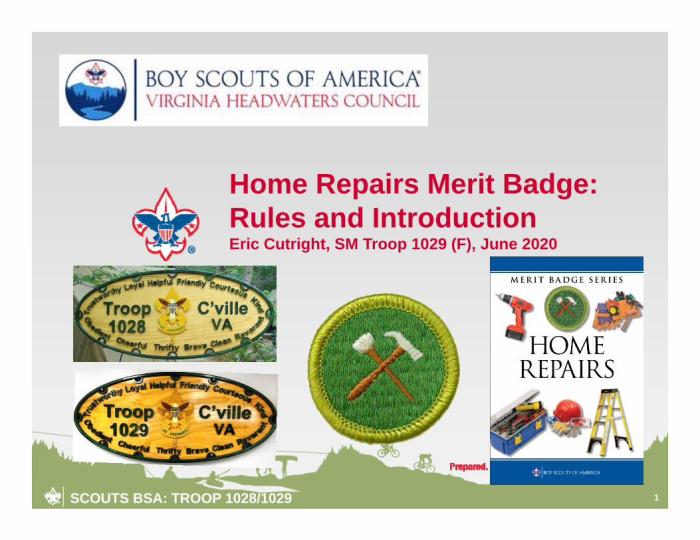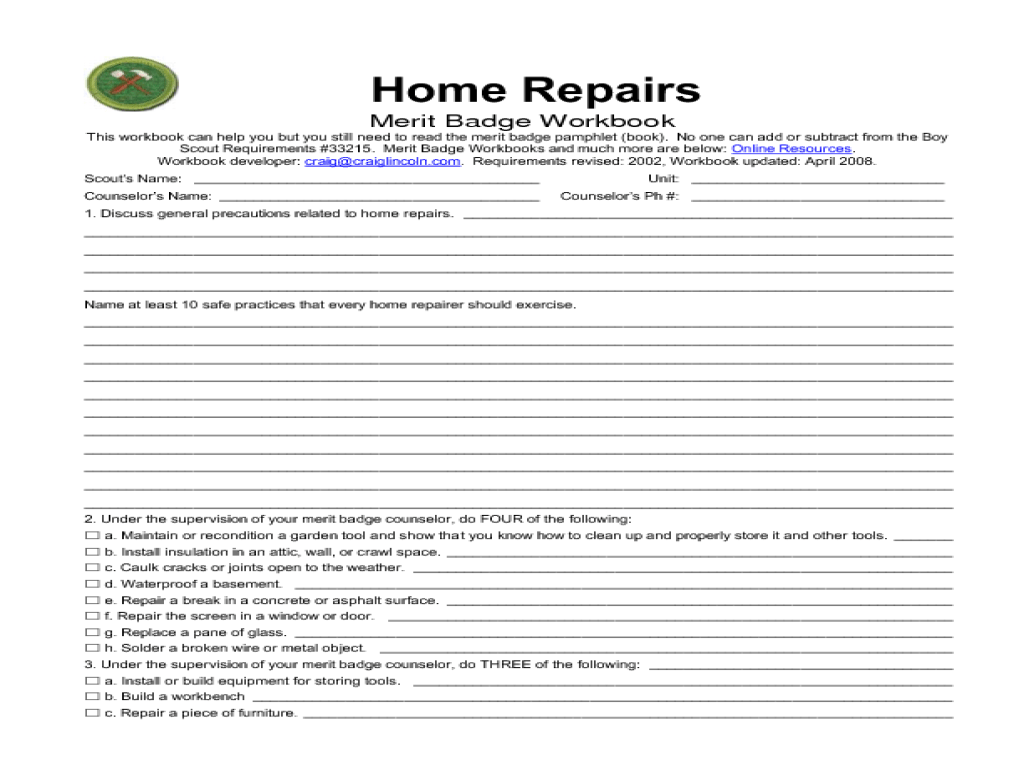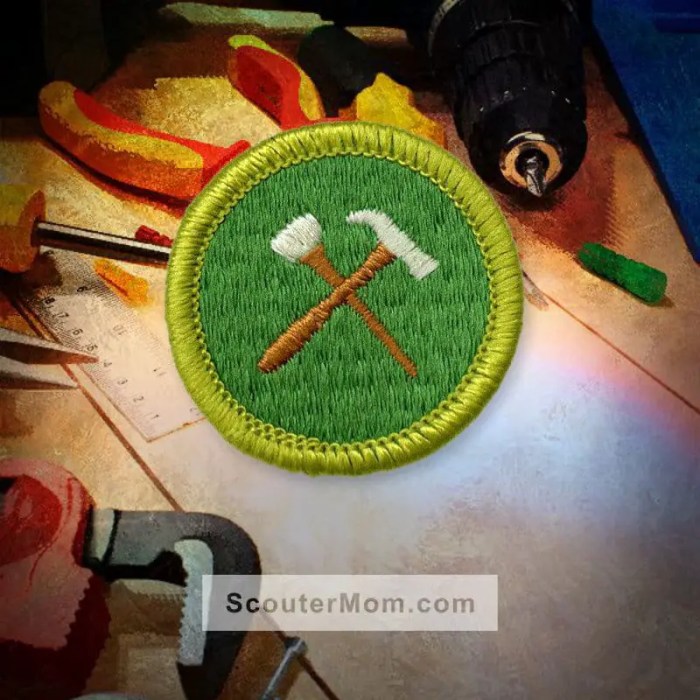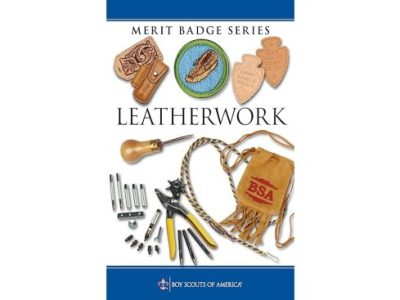Embark on a journey to master the essential skills of home repairs with the Home Repairs Merit Badge Tasks. This comprehensive guide empowers you with the knowledge and techniques to tackle common household repairs, ensuring your home remains in pristine condition.
From basic maintenance to complex electrical and plumbing repairs, this guide covers everything you need to know to become a proficient home handyman.
Introduction
The Home Repairs merit badge teaches Scouts the basic skills needed to maintain and repair their homes. The badge is designed to help Scouts develop self-reliance and a sense of accomplishment, while also learning valuable life skills.To earn the Home Repairs merit badge, Scouts must complete the following requirements:
- Explain the importance of home maintenance and repairs.
- Identify the common tools and materials used in home repairs.
- Demonstrate the ability to perform basic home repairs, such as fixing a leaky faucet, replacing a light switch, and patching a hole in drywall.
- Plan and execute a home repair project.
Tools and Materials
Home repairs require an assortment of essential tools and materials to ensure the proper completion of tasks. These range from basic hand tools to specialized equipment, depending on the nature of the repairs. Safety is paramount when using tools, and it is crucial to follow all instructions carefully and wear appropriate protective gear.
Essential Tools
- Hammer
- Screwdriver set
- Wrench set
- Pliers
- Tape measure
- Level
- Utility knife
- Safety glasses
- Gloves
These tools form the core of a basic toolkit and are suitable for a wide range of home repairs, from simple fixes to more complex projects.
Materials
- Nails
- Screws
- Bolts
- Nuts
- Washers
- Caulk</
- Sealant
- Adhesive
- Sandpaper
- Paint
The specific materials needed will vary depending on the repair being undertaken. It is important to consult with a professional or refer to the manufacturer’s instructions to determine the appropriate materials for the task.
Safety Precautions
Safety is of utmost importance when working with tools and materials. Always wear appropriate protective gear, such as safety glasses, gloves, and a mask when necessary. Read and understand the instructions for all tools and materials thoroughly before use. Avoid using tools that are damaged or in poor condition.
Keep work areas clean and well-lit, and be aware of potential hazards such as electrical wires or sharp objects.
Basic Repair Techniques
Home repairs often involve basic tasks like fixing leaky faucets or replacing light switches. These repairs require understanding how to use tools properly and safely.
Using Tools Properly and Safely
Using tools correctly and safely is essential for effective repairs. Always wear appropriate safety gear like gloves and eye protection. Familiarize yourself with the tool’s function and operation before using it. Avoid overloading tools or using them for unintended purposes.
Proper tool usage ensures efficiency and prevents accidents.
Fixing a Leaky Faucet
A leaky faucet is a common issue that can be easily fixed. Identify the source of the leak, which could be a worn washer or a loose handle. Replace the worn washer or tighten the handle to stop the leak.
If the leak persists, consider replacing the entire faucet.
Replacing a Light Switch
Replacing a light switch involves cutting power to the circuit, removing the old switch, and connecting the new switch to the electrical wires. Ensure the power is off before starting any electrical work. Use a voltage tester to confirm that the power is off.
Carefully disconnect the wires from the old switch and connect them to the new switch, ensuring proper polarity. Secure the new switch in place and restore power to the circuit.
Electrical Repairs

Electrical repairs are a common task for homeowners, but they can be dangerous if not done properly. It’s important to understand the basics of electrical safety before attempting any repairs.Electrical safety starts with understanding the risks involved. Electricity can cause shocks, burns, and even death.
It’s important to take precautions to avoid these risks, such as wearing rubber gloves and using insulated tools.Once you understand the risks, you can start to troubleshoot and repair common electrical problems. Some of the most common problems include:*
-*Blown fuses or tripped circuit breakers
This is usually caused by an overload on the circuit. To fix it, simply replace the fuse or reset the circuit breaker.
-
-*Loose wires
Loose wires can cause sparks and fires. To fix it, simply tighten the wires.
-*Faulty outlets or switches
Faulty outlets or switches can cause shocks or fires. To fix it, replace the outlet or switch.
If you’re not comfortable troubleshooting and repairing electrical problems yourself, it’s best to call a qualified electrician.
Electrical Safety
* Never work on live wires.
- Always turn off the power at the circuit breaker or fuse box before starting any work.
- Use rubber gloves and insulated tools when working on electrical equipment.
- Be aware of the location of electrical wires and cables in your home.
- Never overload circuits.
- If you’re not comfortable working on electrical equipment, call a qualified electrician.
Troubleshooting Electrical Problems
* If a fuse blows or a circuit breaker trips, first check to see if there’s an overload on the circuit. Unplug any appliances or devices that are not essential.
- If a light fixture is not working, check the bulb, the switch, and the wiring.
- If an outlet is not working, check the plug, the wiring, and the circuit breaker or fuse.
Repairing Electrical Problems
* To replace a fuse, simply unscrew the old fuse and screw in a new one of the same amperage.
- To reset a circuit breaker, simply flip the switch to the “off” position and then back to the “on” position.
- To tighten loose wires, simply use a screwdriver to tighten the screws on the wire connectors.
- To replace a faulty outlet or switch, simply unscrew the old one and screw in a new one.
If you’re not comfortable repairing electrical problems yourself, it’s best to call a qualified electrician.
Plumbing Repairs: Home Repairs Merit Badge Tasks

Plumbing systems provide essential functions in homes and buildings, distributing water for consumption, sanitation, and other purposes. Understanding basic plumbing principles enables homeowners to address common problems, ensuring a functional and efficient system.
Fixing a Clogged Drain
Clogged drains are a prevalent plumbing issue. To resolve them, locate the source of the blockage using a drain snake or auger. If the clog is within reach, remove it manually. Otherwise, use a chemical drain cleaner following the manufacturer’s instructions.
For stubborn clogs, consider professional assistance.
Replacing a Washer
Leaking faucets can waste significant amounts of water. Replacing a washer is a straightforward repair that can address this issue. Shut off the water supply, remove the handle, and use a wrench to loosen the packing nut. Replace the old washer with a new one of the same size, tighten the packing nut, and reassemble the faucet.
Carpentry Repairs

Carpentry, the art of woodworking, involves the construction, installation, and repair of structures and fixtures using wood. It’s a versatile skill, allowing individuals to create and maintain various wooden components within their homes.
Basic carpentry repairs include fixing broken windows, building shelves, and repairing furniture. To execute these repairs effectively, it’s essential to understand the fundamentals of woodworking and possess the necessary tools and materials.
Tools and Materials, Home repairs merit badge tasks
Essential carpentry tools include a hammer, saw, drill, measuring tape, and level. For materials, wood is the primary choice, and selecting the appropriate type (e.g., pine, oak, mahogany) depends on the specific repair. Additionally, nails, screws, and wood glue are commonly used to secure wooden components.
Simple Repairs
Fixing a broken window involves removing the damaged glass, measuring and cutting a new piece to fit, and securing it in place with glazing compound. Building a shelf requires cutting wood pieces to the desired dimensions, assembling them using screws or nails, and attaching them to a wall or other surface.
Safety Considerations
When performing carpentry repairs, safety should be paramount. Always wear appropriate safety gear, such as gloves and safety glasses, and use tools properly to avoid injuries. Additionally, ensure adequate ventilation when working with wood or using adhesives to minimize exposure to fumes.
Maintenance and Prevention

Regular home maintenance is crucial to prevent costly repairs and extend the lifespan of your property. By addressing minor issues promptly, you can avoid more significant problems down the road. Here are some tips to help you prevent common home repairs:
Roof Maintenance
- Regularly inspect your roof for missing or damaged shingles, and replace them promptly to prevent leaks.
- Clear gutters and downspouts of debris to prevent clogs and water damage.
- Trim overhanging branches that could damage your roof during storms.
Foundation Maintenance
- Check your foundation for cracks or settling, which could indicate structural issues.
- Ensure proper drainage around your home to prevent water from seeping into the foundation.
- Avoid planting trees or shrubs too close to your foundation, as their roots can damage it.
Plumbing Maintenance
- Inspect plumbing fixtures regularly for leaks and tighten loose connections.
- Run hot water through your taps periodically to prevent mineral buildup.
- Use drain cleaners sparingly, as they can damage pipes over time.
Electrical Maintenance
- Check electrical outlets and switches for loose connections or flickering lights.
- Avoid overloading circuits, as this can cause fires.
- Have your electrical system inspected by a qualified electrician periodically.
Additional Resources
Expanding your knowledge in home repairs is crucial for maintaining a well-functioning living space. Various resources are available to assist you in this endeavor.
Books
Books provide a comprehensive and in-depth understanding of home repair techniques. Consider titles like “Home Repair Bible” by Tom Philbin or “Complete Home Repair Manual” by Editors of Reader’s Digest for comprehensive guidance.
Websites
Numerous websites offer valuable information on home repairs. Popular platforms include Home Depot’s “Home Improvement Library” or Lowe’s “Project Library” for detailed articles and tutorials.
Classes
Local hardware stores, community colleges, and vocational schools often conduct home repair classes. These classes provide hands-on experience and expert instruction.
Home Repair Clubs and Organizations
Joining a home repair club or organization offers benefits such as access to tools, shared knowledge, and networking opportunities. Consider organizations like the National Association of Home Builders (NAHB) or the American Society of Home Inspectors (ASHI).
Final Summary
Whether you’re a seasoned homeowner or just starting out, the Home Repairs Merit Badge Tasks is your indispensable resource for maintaining a safe and well-functioning home. By following these step-by-step instructions and embracing the principles of regular maintenance, you can confidently tackle any home repair challenge that comes your way.
Query Resolution
What are the benefits of earning the Home Repairs Merit Badge?
Earning the Home Repairs Merit Badge demonstrates your proficiency in essential home maintenance and repair skills, enhancing your self-sufficiency and saving you money on costly repairs.
What are the requirements for earning the Home Repairs Merit Badge?
To earn the Home Repairs Merit Badge, you must complete a series of tasks that cover various aspects of home repairs, including tool safety, basic repairs, electrical repairs, plumbing repairs, carpentry repairs, and maintenance.
What are some common home repairs that I can learn to fix?
The Home Repairs Merit Badge Tasks guide covers a wide range of common home repairs, including fixing leaky faucets, replacing light switches, troubleshooting electrical problems, unclogging drains, and making simple carpentry repairs.


